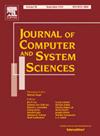几乎聚类图中的支配子着色和CD着色
IF 0.9
3区 计算机科学
Q1 BUSINESS, FINANCE
引用次数: 0
摘要
本文研究了着色的两种变体——支配着色和类支配着色。在这两个问题中,我们给定一个图G和一个r∈N,目标是用最多r种颜色给顶点上色。在支配着色中,我们要求对于每个v∈v (G),有一个颜色c,使得v支配所有颜色c的顶点。在类支配着色中,我们要求对于每个颜色c,有一个v∈v (G),它支配所有颜色c的顶点。我们证明当用图的CVD集的大小参数化时,支配着色是FPT,并且类支配着色是用CVD集的大小加上剩余的团的数量参数化的FPT。在此过程中,当问题由图的双覆盖的大小参数化时,我们设计了更简单的算法。当参数为图团调制器的大小时,我们设计了一个随机化的单指数时间算法。本文章由计算机程序翻译,如有差异,请以英文原文为准。
Dominator coloring and CD coloring in almost cluster graphs
In this paper, we study two variants of Coloring - Dominator Coloring and Class Domination Coloring. In both problems, we are given a graph G and a and the goal is to properly color the vertices with at most ℓ colors. In Dominator Coloring, we require for each , a color c such that v dominates all vertices colored c. In Class Domination Coloring, we require for each color c, a which dominates all vertices colored c. We prove that Dominator Coloring is FPT when parameterized by the size of a graph's CVD set and that Class Domination Coloring is FPT parameterized by CVD set size plus the number of remaining cliques. En route, we design simpler algorithms when the problems are parameterized by the size of a graph's twin cover. When the parameter is the size of a graph's clique modulator, we design a randomized single-exponential time algorithm.
求助全文
通过发布文献求助,成功后即可免费获取论文全文。
去求助
来源期刊

Journal of Computer and System Sciences
工程技术-计算机:理论方法
CiteScore
3.70
自引率
0.00%
发文量
58
审稿时长
68 days
期刊介绍:
The Journal of Computer and System Sciences publishes original research papers in computer science and related subjects in system science, with attention to the relevant mathematical theory. Applications-oriented papers may also be accepted and they are expected to contain deep analytic evaluation of the proposed solutions.
Research areas include traditional subjects such as:
• Theory of algorithms and computability
• Formal languages
• Automata theory
Contemporary subjects such as:
• Complexity theory
• Algorithmic Complexity
• Parallel & distributed computing
• Computer networks
• Neural networks
• Computational learning theory
• Database theory & practice
• Computer modeling of complex systems
• Security and Privacy.
 求助内容:
求助内容: 应助结果提醒方式:
应助结果提醒方式:


